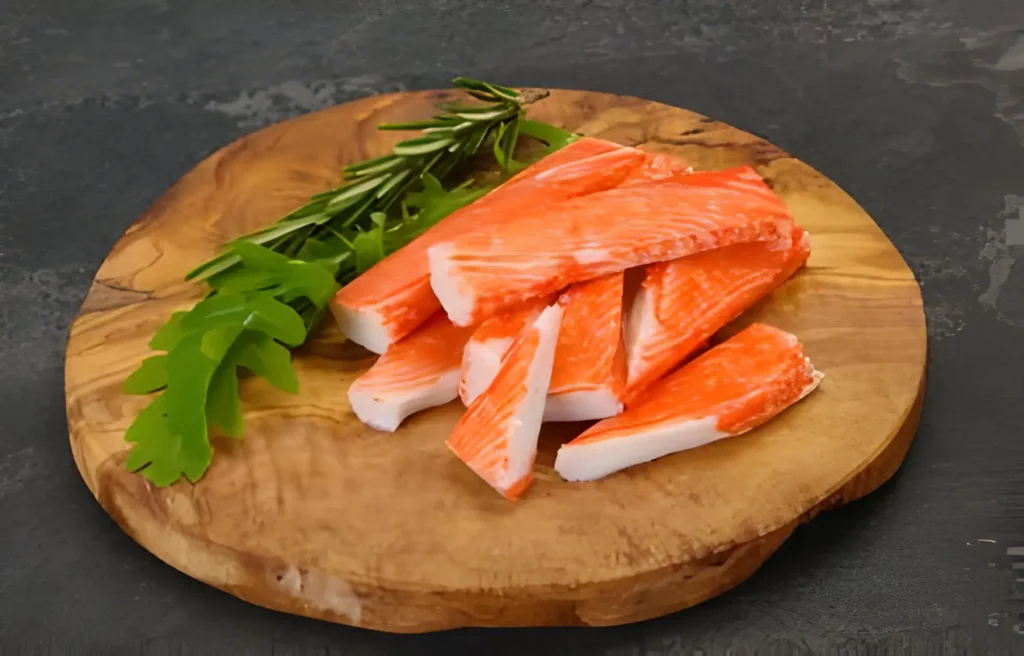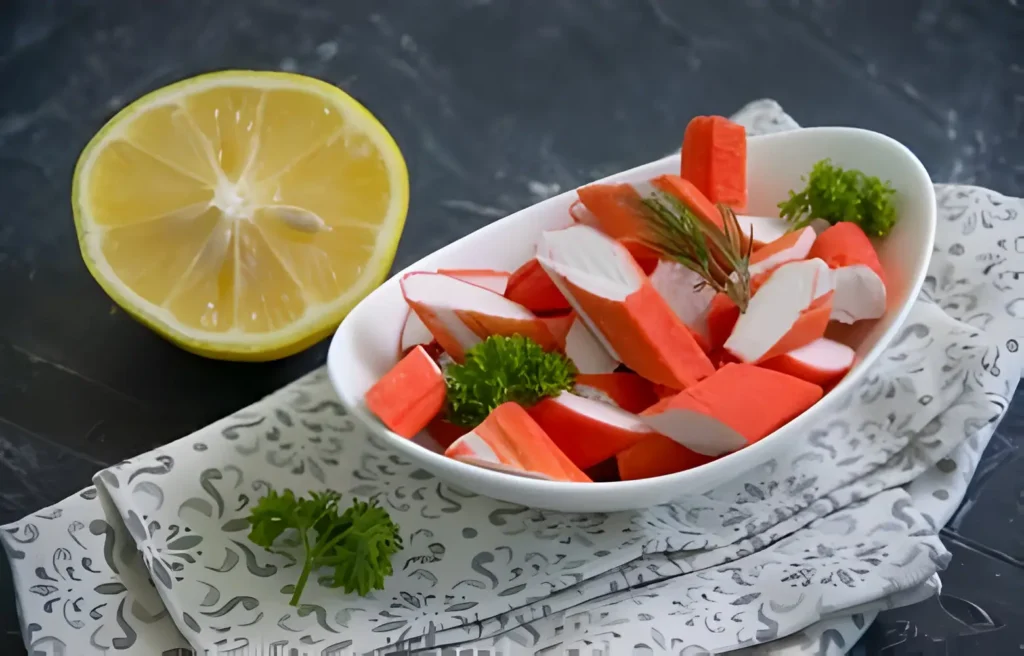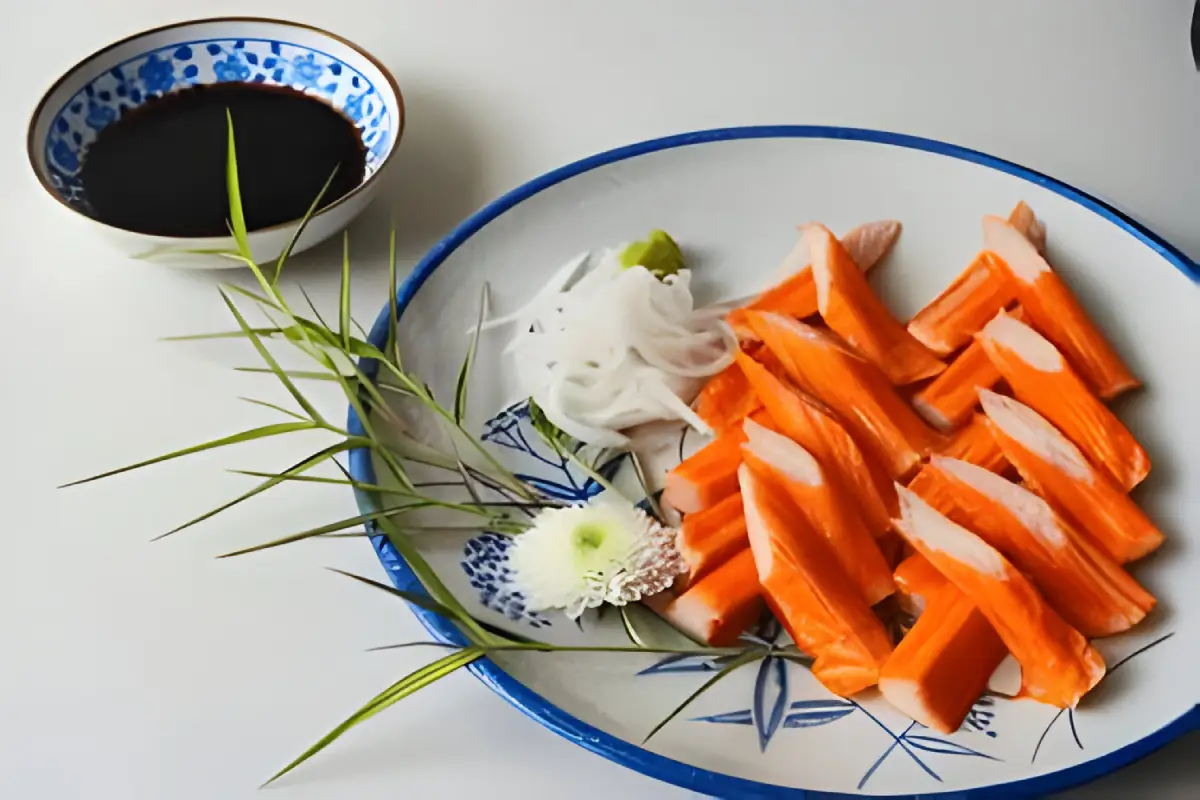In the mosaic of culinary innovation, imitation crab stands out as a versatile and intriguing ingredient that has found its way into the hearts of food lovers and kitchens worldwide. Known for its ability to mimic the delicate taste and texture of genuine crab meat, this seafood substitute is not just a staple in sushi rolls but a star in a myriad of dishes spanning diverse cuisines. This exploration into the world of imitation crab aims to shed light on its composition, nutritional value, and the plethora of ways it can elevate everyday cooking. From sushi to salads and beyond, join us as we delve into the culinary potential of imitation crab, offering insights, recipes, and tips to make the most of this fascinating food.
Introduction
What is Imitation Crab?
Manufacturers make this imitation meat from surimi, which is a processed fish paste, often from pollock. Through a careful blend of ingredients and flavors, manufacturers transform surimi into products that offer the taste and texture reminiscent of real crab meat, making it a popular and cost-effective alternative.
Composition and Manufacturing
The journey of imitation crab from fish to fork is a testament to food science and culinary craftsmanship. Manufacturers mix surimi, the primary ingredient, with water, starch, egg whites, and seasonings before coloring and shaping it to resemble crab meat. This process not only extends the shelf life of the fish but also makes it accessible to a broader audience.
For more detailed information on what imitation crab is made of and how it’s produced: Check this article.
Nutritional Value
While not as rich in omega-3 fatty acids as genuine crab meat, the imitation one offers its own set of nutritional benefits, including being low in fat and a good source of protein. However, it’s also worth noting that it can be high in sodium and contains gluten, making it less suitable for those on specific diets or with certain allergies.
Understanding the essence of crab paves the way for appreciating its role in culinary applications. As we explore its traditional and innovative uses in the kitchen, it becomes clear that this ingredient’s versatility knows no bounds. Stay tuned as we dive into the many ways this imitation meat can be featured in dishes, bringing a touch of seafood delight to meals without breaking the bank.
Although imitation crab does not have the same nutritional value as the real one, it is not considered bad to consume unless you are allergic to the ingredients in the blend. Read more.
Culinary Uses of Imitation Crab

Imitation crab, with its mild flavor and adaptable texture, finds harmony in a variety of culinary contexts. From traditional favorites to innovative creations, its presence enhances the dishes it graces, offering a seafood experience that’s both accessible and delightful.
Versatile Applications in Cooking
Sushi and Seafood Dishes
Perhaps most recognized in the realm of sushi, imitation crab is a key ingredient in California rolls and other sushi varieties. Its ability to blend seamlessly with other flavors while maintaining a distinct seafood essence makes it a sushi staple. Beyond sushi, it’s also used in seafood salads, cakes, and as filling in dumplings and seafood pot pies, showcasing its range in texture and taste.
Salads and Appetizers
This imitation meat shines in cold salads, where you can mix it with crisp vegetables, creamy dressings, or tangy vinaigrettes. In appetizers, it often appears in the form of crab dip, crab salad on endive leaves, or stuffed mushrooms, offering a light yet flavorful start to any meal.
Pasta and Rice Dishes
The subtle sweetness of imitation crab complements the rich sauces of pasta dishes and the savory notes of rice bowls. Whether tossed in a creamy Alfredo, mixed into a spicy seafood pasta, or served atop a vibrant paella, it adds a seafood dimension without overwhelming the other ingredients.
Soups and Stews
In soups and stews, this meat contributes texture and flavor, especially in recipes like corn and crab chowder, seafood bisque, or traditional Asian soups where seafood plays a starring role. Its ability to absorb and enhance the surrounding flavors makes it a hearty addition to any broth.
Best Practices for Cooking
When cooking with imitation crab, add it toward the end of the cooking process to preserve its texture and flavor. Overcooking can lead to a rubbery texture, so gentle heating is key. For the best results, use this imitation meat in dishes where it can shine on its own or complement other flavors.
The culinary versatility of imitation crab is a testament to its enduring popularity in both home kitchens and professional settings. As we explore further, we’ll uncover tips for selecting high-quality imitation crab and best practices.
Discover more recipes.
Tips for Choosing and Preparing Crab

To fully enjoy the culinary potential of imitation crab, selecting high-quality products and understanding the best ways to prepare them are crucial steps. These tips ensure that your dishes not only taste great but also maintain the integrity of this versatile ingredient.
Selecting High-Quality Imitation Crab
- Read the Ingredients: Look for products with a short list of recognizable ingredients. High-quality imitation crab often contains more fish (like pollock) and fewer fillers or artificial additives.
- Consider the Texture: Quality imitation crab should have a firm yet tender texture that mimics real crab meat. Avoid products that seem overly mushy or rubbery.
- Check the Packaging: Opt for well-sealed packages without signs of freezer burn or damage, as these can affect the product’s taste and texture.
Best Practices for Cooking with Imitation Crab
- Thaw Properly: If using frozen imitation crab, thaw it in the refrigerator overnight rather than at room temperature or under hot water to maintain its texture.
- Gentle Cooking: Since imitation crab is precooked, you only need to warm it through. Add it to hot dishes at the last minute to avoid overcooking.
- Use in Cold Dishes: Imitation crab shines in cold preparations where its flavor and texture can stand out. It’s excellent in salads, cold pasta dishes, or as a topping on a fresh seafood taco.
Incorporating Imitation Crab into Your Dishes
- Mixing with Other Ingredients: When adding imitation crab to dishes with bold flavors or sauces, consider shredding or chopping it into bite-sized pieces to ensure it integrates well with the other components.
- Enhancing Flavor: Though tasty on its own, imitation crab can be enhanced with a squeeze of lemon juice, a dash of Old Bay seasoning, or a light brush of melted butter before serving to bring out its seafood-like qualities.
- Presentation Matters: For dishes where imitation crab is a key feature, such as in sushi rolls or salads, take care with presentation to make the dish visually appealing as well as delicious.
By adhering to these tips for selecting and preparing imitation crab, you can elevate your culinary creations, making the most of this affordable and accessible ingredient. Next, we’ll delve into innovative recipes that showcase the versatility and appeal of imitation crab, inspiring you to experiment with new flavors and techniques in your own kitchen.
Innovative Recipes Featuring Imitation Crab

The adaptability of imitation crab opens a treasure trove of culinary possibilities. Whether you’re seeking comfort food or light, refreshing meals, these innovative recipes demonstrate how easily imitation crab can be incorporated into your cooking repertoire, offering flavors that are sure to delight.
Creative Recipe Ideas
Cakes
- These imitation crab cakes are a twist on the classic, with a crispy outside, tender inside, and full of flavor. Mix shredded imitation crab meat with breadcrumbs, mayonnaise, dijon mustard, and your choice of seasonings. Form into patties and pan-fry until golden brown. Serve with a tangy remoulade or a simple squeeze of lemon.
Salad
- For a light and satisfying option, toss chunks of imitation crab with mixed greens, avocado, cucumber, and cherry tomatoes. Dress the salad with a citrus vinaigrette for a refreshing meal that’s perfect for lunch or a light dinner.
Sushi
- Home chefs can easily make sushi rolls featuring imitation crab as the star ingredient. Combine it with creamy avocado, crisp cucumber, and sushi rice, then roll it up in nori seaweed sheets. Slice into bite-sized pieces and serve with soy sauce, wasabi, and pickled ginger for an authentic sushi experience.
Pasta
- To create a hearty pasta dish, sauté garlic and onion, then add diced tomatoes and cream to form a rich sauce. Stir in shredded imitation crab meat and cooked pasta, garnishing with parsley and a sprinkle of parmesan cheese for a quick and delicious dinner option.
Best Practices for Cooking with Imitation Crab
While exploring these recipes, remember that imitation crab is precooked. Add it toward the end of the cooking process to warm through without becoming tough. Its mild flavor pairs well with a variety of ingredients, allowing for creativity and experimentation in the kitchen.
These innovative recipes featuring imitation crab are just the beginning. The versatility of this ingredient encourages experimentation, inviting home cooks to explore new flavors and dishes. Whether incorporated into familiar favorites or used as the foundation for something entirely new, imitation crab proves to be a valuable addition to any culinary repertoire.
In the next section, we’ll address some frequently asked questions about imitation crab, providing additional insights and tips to help you make the most of this versatile seafood alternative.
Frequently Asked Questions
Navigating the world of imitation crab can spark curiosity and questions, especially for those experimenting with it for the first time. Here are answers to some frequently asked questions that can help clarify common uncertainties and enhance your cooking experience with imitation crab.
- Is imitation crab safe to eat if I’m allergic to shellfish?
While imitation crab is made from fish, it often contains flavorings or additives derived from shellfish, and cross-contamination is possible. It’s best to consult the packaging or contact the manufacturer if you have a shellfish allergy. - Can imitation crab be eaten straight from the package?
Yes, since imitation crab is fully cooked during the manufacturing process, it can be eaten directly from the package. It’s a convenient option for salads, cold appetizers, or a quick snack. - How should I store leftover imitation crab?
Leftover imitation crab should be stored in an airtight container in the refrigerator and consumed within 2-3 days. For longer storage, you can freeze it, though this may slightly alter its texture. - Can I cook imitation crab in hot dishes?
Absolutely! You can incorporate imitation crab into hot dishes like soups, stews, pastas, and casseroles. Just remember to add it towards the end of the cooking process to heat it through without compromising its texture. - How can I tell if imitation crab has gone bad?
Spoiled imitation crab may have a sour or unpleasant odor, a slimy texture, or visible signs of mold. If you notice any of these indicators, it’s best to discard the product. - Does imitation crab offer any nutritional benefits?
Imitation crab is low in calories and fat, and it provides a moderate amount of protein. However, it’s also high in sodium and contains added sugars and preservatives, making it less nutritious than real crab meat.
Conclusion
Imitation crab, a versatile and accessible ingredient, has journeyed through our kitchens and onto our plates, revealing its potential to transform everyday meals into something special. From its humble origins as surimi to its place in the spotlight of both traditional and innovative recipes, imitation crab has proven to be more than just a substitute for real crab meat; it’s a culinary chameleon, adept at enhancing a wide range of dishes with its unique texture and flavor.
Throughout this exploration, we’ve discovered the essence of imitation crab. We’ve delved into the nutritional aspects, demystified common questions, and provided practical tips for selecting and preparing it. The diverse array of recipes in this guide showcases the ingredient’s versatility, whether it’s the star of a dish or playing a supporting role.
The journey doesn’t end here. The culinary world is vast and ever-evolving, and imitation crab stands ready to adapt to new trends, diets, and tastes. It invites experimentation and creativity, challenging home cooks and professional chefs alike to rethink traditional seafood dishes and explore new flavor combinations.
As you experiment with imitation crab in your kitchen, remember that cooking is as much about the process as it is about the outcome. Each dish you create is an opportunity to learn, to share, and to enjoy the rich tapestry of flavors. So, embrace imitation crab with an open mind and a curious palate, and let it inspire you.
Thank you for joining us on this delicious journey. May your meals be filled with joy, your kitchen with laughter, and your table with loved ones ready to share in the bounty of your efforts. Here’s to many more flavorful adventures ahead!

